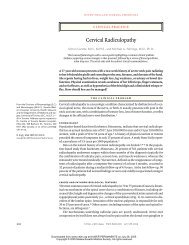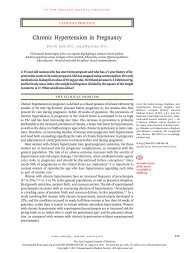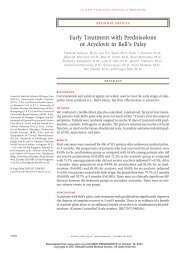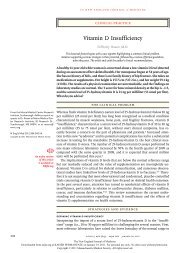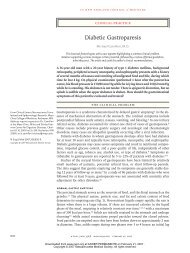Hypoparathyroidism - Q-Notes for Adult Medicine
Hypoparathyroidism - Q-Notes for Adult Medicine
Hypoparathyroidism - Q-Notes for Adult Medicine
You also want an ePaper? Increase the reach of your titles
YUMPU automatically turns print PDFs into web optimized ePapers that Google loves.
clinical practice<br />
tions of chromosome 22q11.2, affects 1 in 4000<br />
to 5000 live births. 39-41 Activating mutations in<br />
the extracellular calcium-sensing receptor are<br />
also frequently identified in patients with inherited<br />
hypoparathyroidism and are manifested as<br />
autosomal dominant hypocalcemia at any age<br />
(Tables 1 and 2). 10-13 Mutations in the pre-proPTH<br />
gene and in transcription factors that control<br />
parathyroid gland development are rare but shed<br />
light on basic developmental mechanisms. 2,15-18<br />
Familial hypoparathyroidism due to dysgenesis of<br />
the parathyroid glands results from mutations in<br />
the transcription factors GCMB (glial cells missing<br />
B) or GCM2 (glial cells missing 2) 19-21 and<br />
GATA3 2,3,22,23 and possibly the transcription factor<br />
SOX3 (Sry-box 3) (Tables 1 and 2). 31 Other<br />
disorders that include hypoparathyroidism are<br />
the hypoparathyroidism, retardation, and dysmorphism<br />
syndrome and disorders due to mitochondrial-gene<br />
defects (Table 2). 2,3,36-38,42,43<br />
Evaluation<br />
Review of the patient’s medical and family histories<br />
may suggest the cause of hypocalcemia.<br />
A history of neck surgery suggests that parathyroid<br />
function may have been compromised by the<br />
surgical procedure. A family history of hypocalcemia<br />
suggests a genetic cause (Table 2). The<br />
presence of other autoimmune endocrinopathies<br />
(e.g., adrenal insufficiency) or candidiasis prompts<br />
consideration of autoimmune polyendocrine syndrome<br />
type 1. 32-34 Immunodeficiency and other<br />
congenital defects point to the DiGeorge syndrome<br />
(Table 2). 39-41<br />
Physical examination should include an assessment<br />
of neuromuscular irritability by testing <strong>for</strong><br />
Chvostek’s and Trousseau’s signs. Chvostek’s sign<br />
is elicited by tapping the cheek (2 cm anterior to<br />
the earlobe below the zygomatic process) over the<br />
path of the facial nerve. A positive sign is ipsilateral<br />
twitching of the upper lip. Trousseau’s sign<br />
is elicited by inflating a sphygmomanometer<br />
placed on the upper arm to a level above the<br />
systolic blood pressure <strong>for</strong> 3 minutes. A positive<br />
sign is the occurrence of a painful carpal spasm.<br />
The skin should be examined carefully <strong>for</strong> a neck<br />
scar (which suggests a postsurgical cause of hypocalcemia);<br />
<strong>for</strong> candidiasis and vitiligo (which are<br />
suggestive of APS-1); and <strong>for</strong> generalized bronzing<br />
and signs of liver disease (which are suggestive<br />
of hemochromatosis). Features such as growth<br />
failure, congenital anomalies, hearing loss, or<br />
retardation point to the possibility of genetic<br />
disease.<br />
Laboratory testing should include measurements<br />
of serum total and ionized calcium, albumin,<br />
phosphorus, magnesium, creatinine, intact<br />
PTH, and 25-hydroxyvitamin D (25[OH] vitamin<br />
D) levels. Albumin-corrected total calcium is calculated<br />
as follows:<br />
Corrected total calcium = measured total calcium<br />
+ 0.8 (4.0 − serum albumin),<br />
where calcium is measured in milligrams per<br />
deciliter and albumin is measured in grams per<br />
deciliter. <strong>Hypoparathyroidism</strong> is diagnosed when<br />
the intact PTH level is normal or inappropriately<br />
low in a patient with subnormal serum albumin<br />
corrected total or ionized calcium values, after<br />
hypomagnesemia has been ruled out. Serum<br />
phosphorus levels are usually high or at the high<br />
end of the normal range. Patients with pseudohypoparathyroidism<br />
have a laboratory profile that<br />
resembles that in patients with hypoparathyroidism<br />
(i.e., low calcium and high phosphorus levels),<br />
but they have elevated PTH levels (Table 1).<br />
It may be difficult to rule out hypomagnesemia<br />
as the cause of or a contributor to hypocalcemia<br />
because the serum magnesium level may be normal,<br />
even when intracellular magnesium stores<br />
are reduced. Once magnesium depletion progresses,<br />
however, serum levels decrease to subnormal<br />
levels. In general, if the primary disturbance is<br />
magnesium depletion, serum calcium levels are<br />
only slightly decreased. Intact PTH is often detectable<br />
but inappropriately low.<br />
Measurement of 25(OH) vitamin D levels is<br />
essential to rule out vitamin D deficiency as a<br />
contributor to or cause of hypocalcemia. In classic<br />
vitamin D deficiency, intact PTH levels are<br />
elevated, and serum phosphorus levels are low<br />
or at the low end of the normal range, in marked<br />
contrast to the high levels in hypoparathyroidism.<br />
Measurement of 1,25(OH) 2 vitamin D levels is<br />
generally not necessary in the initial evaluation<br />
of patients with hypoparathyroidism.<br />
Measurements of urinary calcium, magnesium,<br />
and creatinine in a 24-hour collection can<br />
also be helpful in the diagnosis of hypoparathyroidism.<br />
Low urinary calcium levels may be present<br />
in both severe hypocalcemia due to hypo-<br />
n engl j med 359;4 www.nejm.org july 24, 2008 393<br />
Downloaded from www.nejm.org at KAISER PERMANENTE on July 23, 2008 .<br />
Copyright © 2008 Massachusetts Medical Society. All rights reserved.






